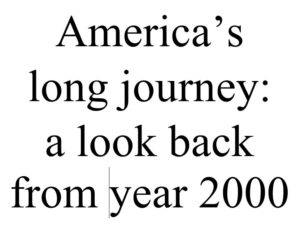
A few of the most conspicuous differences between 1850 and 1800, looking backward:
* The 1800 census counted the population as 5,300,000 (4,400,000 free, 900,000 enslaved). Some of the states had abolished slavery, but it was not yet a contentious, sectional issue. Slavery was an institution that seemed clearly destined to wither and die, as soon as society could find a way to deal with the problems that would result. The new Americans did not yet think of themselves as primarily free or slave states, but – as they had done during England’s long colonial rule – as one of three well-recognized types of colonies — New England, the South, and the Middle colonies of New York, Pennsylvania, and New Jersey.
* The racial and ethnic composition of America was far simpler, being primarily British (English, Scottish, Welch, Scots-Irish) and German. Indians and slaves were, in a sense, invisible to their contemporaries; there, but not citizens.
* Andrew Jackson, Henry Clay, Samuel F.B. Morse, Francis Scott Key, Winfield Scott were names unknown. There was no railroad, no telegraph, no steam-driven travel by water. Communication was by mail or messenger, and transportation was by horse, boat, stagecoach or foot.
* The Union consisted of the original 13 states plus Vermont, Kentucky, and Tennessee. Its boundaries were compact and logical – to the East, the Atlantic, to the West, the Mississippi, to the North, British North America, to the South, East and West Florida. In 1800, nobody was dreaming of a republic stretching to the far Pacific. Given the difficulties of travel and trade across the Appalachians, it was still an open question whether the republic’s seacoast and interior sections could hold together in the long run.
& & &
In looking at the nineteenth century, we have covered a lot of territory. Here, just as a crib sheet, is a reminder of the ground we have traversed, in the order it occurred, rather than the order in which we covered it working our way back from the present.
The Election of 1800 – Jefferson’s revolution – Jefferson and Marshall – Great, forgotten, Gallatin – The shores of Tripoli – Louisiana Purchase, Louisiana adjustments – Burr – Lewis and Clark – The Embargo – Jefferson – John Adams’ Son – The War of 1812 – Westward movement – Jackson and Florida – The Panic of 1819 – The Missouri Compromise – “A Firebell in the night” – The Great Secretary of State – Denmark Vesey – The last New Englander – The Election of 1828 – Nat Turner’s long shadow – Turnpikes, canals, and steam – Jackson and the Bank – Jackson and nullification – Jackson and the Cherokee Removal – Democracy in America – Andrew Jackson – Old man eloquent – The Panic of 1837 – Tippecanoe and Tyler Too – The Republic of Texas – Sam Houston – The 1840s and Utopia – Abolition – The telegraph – The Mormon emigration – The Mexican War – California and gold – Compromise of 1850 – Uncle Tom’s Cabin – Mrs. Stowe and Mrs. Hentz – Whigs and Republicans – The politics of the house divided – Kansas-Nebraska Act of 1854 – Bleeding Kansas – Long-distance telegraph – Lincoln and Douglas – John Brown’s raid – The election of 1860 – Mr. Lincoln – A conflict of loyalties – The Civil War – The South in ruins – Race and Reconstruction – Vengeance – Transcontinental – Credit Mobilier and corruption – The North and the Gilded Age – Cowboys and Indians and nesters – Labor and antitrust and reform – Electricity – Telephone – Spanish American War.
An inadequate survey, of course, but perhaps better than nothing at all.